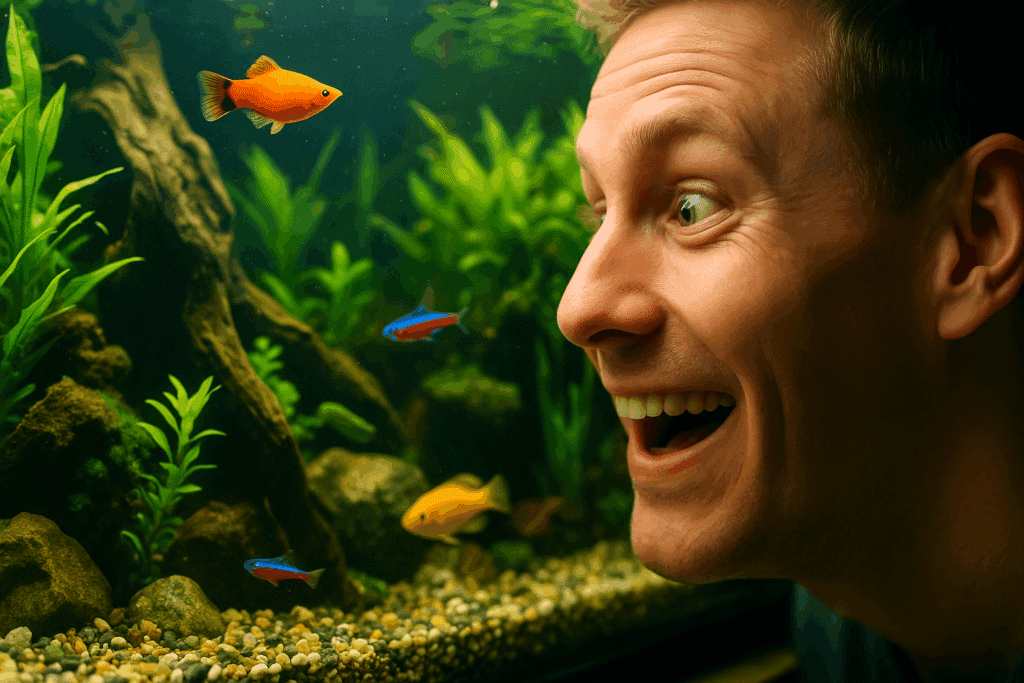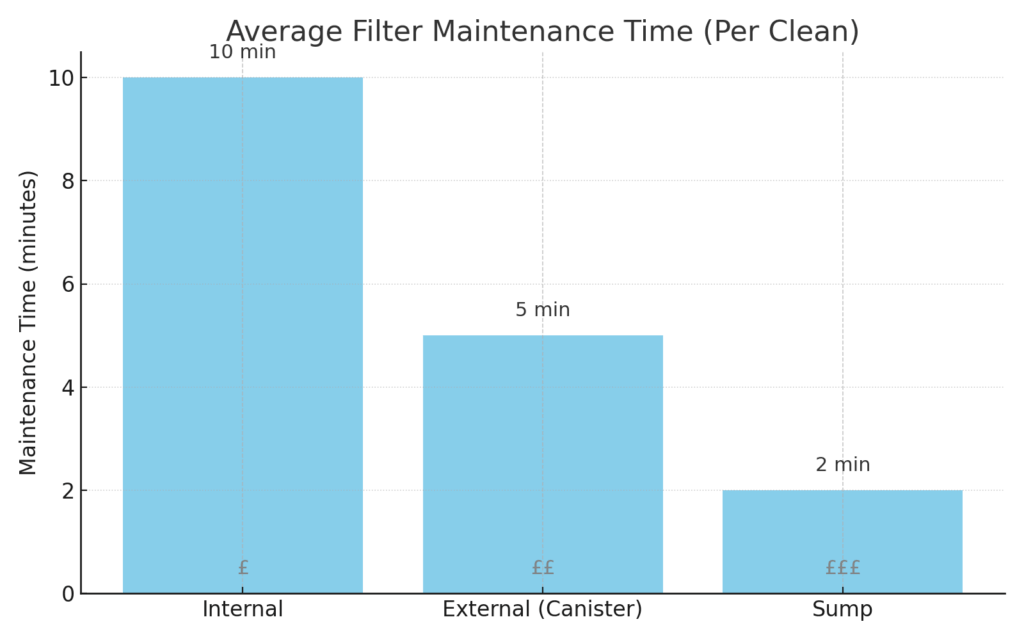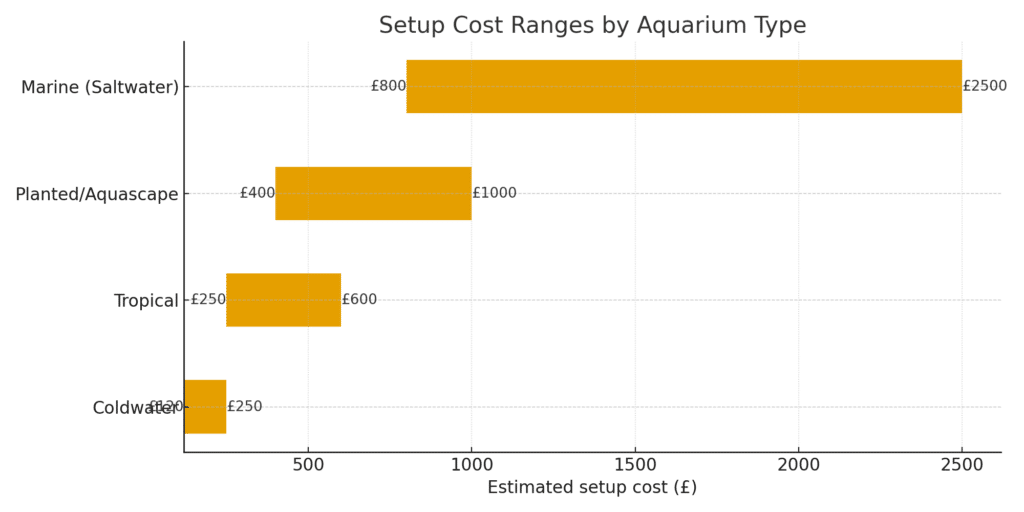🐟 How Much Does It Actually Cost to Set Up a Fish Tank from Scratch?
7 minutes
- 🧾 The Quick Answer
- 🎯 What You Can Expect from This Article
- Why It’s Hard to Get a Straight Answer on Cost
- What Drives the Price Up
- What Keeps the Price Down
- Historical Pricing Trends
- Typical Cost Ranges
- Initial Cost vs. Running Cost
- 💭 Is It Really Worth It?
- Financing Options
- 💬 Pricing FAQs
- 🧠 The Pragmatic Takeaway
- One Last Thought
Fish tanks — or “aquariums” if you’re from Solihull — have been a part of my life for as long as I can remember.
From walking around the fish room open-mouthed as a little lad at my dad’s old pet warehouse (R.J. Cooks in West Bromwich) to climbing inside our 15,000-litre display tank to give it a scrub, I’ve spent most of my life surrounded by glass boxes full of water.
I even dragged my wife, Sarah, around four — yes, four — public aquariums on our honeymoon. (She’s still with me, somehow.)
So, if you’ve clicked on this article, I’m guessing you’re about to take the plunge yourself — and you want to know the real cost of starting the hobby.
Not the sugar-coated version, but the honest truth from someone who’s been through it all.

🧾 The Quick Answer #
If you’re after a rough ballpark before diving in, here it is:
| Setup Type | Average Setup Cost | Typical Size | Who It’s For |
|---|---|---|---|
| Coldwater | £120–£250 | 60–100L | Simple, hardy setups (goldfish, minnows) |
| Tropical | £250–£600 | 100–200L | The most popular option for beginners |
| Planted/Aquascape | £400–£1,000 | 100–200L | For the creative types who want a living landscape |
| Marine (Saltwater) | £800–£2,500+ | 200L+ | For those chasing that coral reef dream |
💡 Quick takeaway: You can start a solid, enjoyable setup for around £120–£600.
At the very bottom end, 30–60L starter kits begin at about £60, but you’ll still need to budget for decoration, fish, possibly a cabinet, water treatments, and basic accessories.
That’s why, in reality, a well-equipped and properly balanced tank usually falls in the £250–£600 range — not a budget kit you’ll replace in six months, but something that’s reliable, good-looking, and easy to live with.
🎯 What You Can Expect from This Article #
In the next few minutes, I’ll walk you through:
- What actually drives aquarium costs up (and how to control them)
- Where you can sensibly save money without cutting corners
- What a realistic setup looks like for different budgets
- The honest truth about ongoing costs
- And ultimately — whether it’s really worth it (spoiler: it is)
By the end, you’ll have a clear idea of what kind of tank fits your lifestyle, space, and budget — so you can get started with confidence and zero guesswork.
Why It’s Hard to Get a Straight Answer on Cost #
Fishkeeping is a bit like cooking. You can make beans on toast for pennies, or you can turn the same ingredients into something Michelin-worthy. Both feed you — one just takes a bit more kit (and patience).
Aquariums come in every size and ambition level. Some are simple and peaceful; others are living art installations with lighting schedules and CO₂ systems that need their own spreadsheet.
The key thing to remember? You don’t need to start big. You just need to start right.
What Drives the Price Up #
These are the main factors that make the price climb — not because they’re “extras,” but because they shape how stable, reliable, and impressive your setup will be.
- Tank size – Bigger tanks cost more, not only to buy but to heat, light, and maintain.
- Shape – Believe it or not, a complicated shape makes an aquarium more expensive. A corner tank or even a round tank will always cost more than your standard rectangle.
Tanks with bow fronts are becoming less and less common too. Most (not all) bent glass comes from China, and a number of years ago the Chinese government imposed a tax on the use of kilns in manufacturing. The result? Many manufacturers stopped producing bent glass altogether because the costs became too high.
So, while curved tanks look great, they’re often pricier simply because there aren’t many being made anymore. - Type of setup – Coldwater and tropical systems are simplest; marine (saltwater) setups are the most technical and costly.
- Filter type – Your choice of filtration can also make a noticeable difference. Generally speaking, internal filters are the cheapest, external canister filters sit in the middle, and sump systems (often used in marine setups) are at the higher end.
Their ease of maintenance tends to follow the same order — internal filters are quick and simple, externals take a bit more time, and sumps require the most attention.

Filter Maintenance Time by Type #
(Based on typical cleaning times and cost levels)
Internal filters are the quickest to clean, while sump systems offer the most flexibility but require more time and cost.
- Equipment quality – Filters, heaters, and lights are the beating heart of your aquarium. Good kit costs more up front but lasts longer and works better.
- Specialised setups – Planted tanks and reefs need extra lighting, CO₂, or salt-mix gear.
- Cabinetry and finish – Custom stands or sleek furniture-grade designs always look smart but add cost.
- Brand – Some brands are known to be more expensive — and often for good reason. Companies like ADA, Nyos, and hand-built aquarium makers charge more because of their craftsmanship and precision, much like any high-end craftsperson.
Others, such as Juwel, Cleair, and Red Sea, offer very good quality but on a more mass-produced scale, which helps keep prices more accessible.
The difference isn’t just in the logo — it’s in the finish, the materials, and how much human care goes into each build.
You don’t need everything on this list — just know what each choice does to the budget.
What Keeps the Price Down #
You can absolutely start fishkeeping without emptying your wallet. Here’s how:
- Pick a practical size – Around 60–100 L gives you good stability without being pricey.
- Go for a kit – Starter tanks from reputable brands include filter, light, and lid.
- Choose hardy fish – Guppies, danios, and tetras make great first choices.
- Skip tech early on – Fancy lighting controllers and auto-feeders can come later.
- Do your own maintenance – The cheapest (and best) investment is time.
6. Mass-produced setups can actually be great value.
“Mass produced” is often used as a bit of an insult, but in reality, it usually means a manufacturer has found a formula that works — and a way to repeat it cheaply.
Check reviews on these more affordable tanks, and also look at the availability of spares before you buy.
Some manufacturers, like Ciano, manage to keep their aquarium prices remarkably low. They’re open about how they do it: they make little (if anything) on the tank itself, but their filters use replaceable elements that need swapping regularly.
It’s a model that works well for them and for many hobbyists — but it’s worth understanding what you’re signing up for.
Think of it like printers: you can buy a crazy-cheap printer, but the ongoing ink cartridges might end up costing more than the printer itself.
It’s not bad — just something to be aware of when planning your long-term costs.
That combination of smart choices gives you a solid, enjoyable tank without cutting corners.
Historical Pricing Trends #
Inflation is what it is — things tend to get more expensive over time, and aquariums are no exception.
The price of glass has gone up significantly in the past 15 years. Even I, on occasion, do a double take at the cost of an all-glass aquarium (AGT).
Freight has also played a huge role. Most aquariums are manufactured overseas — and even if they’re made here, the glass itself is often imported. During Covid, the cost of importing a 40ft container shot up from less than $3,000 to over $25,000.
That’s come down considerably since, but we’ll never return to pre-Covid shipping prices.
On top of that, technology keeps improving — better filters, lighting, and materials are developed all the time. These innovations make our lives as fishkeepers easier, but they also nudge prices up.
So yes, unfortunately, things are more expensive than they used to be — but the trade-off is that today’s gear is safer, smarter, and far more reliable.
Typical Cost Ranges #
Here’s what most newcomers actually spend when setting up properly — not the bare minimum, but realistic, working systems:
| Type of Tank | Typical Size | Setup Cost (Approx.) | Includes |
|---|---|---|---|
| Coldwater | 60–100 L | £120–£250 | Tank, filter, light, gravel, conditioner |
| Tropical | 100–200 L | £250–£600 | Heater, filter, light, décor |
| Planted | 100–200 L | £400–£1,000 | CO₂, LED lighting, substrate, hardscape |
| Marine (Saltwater) | 200 L+ | £800–£2,500+ | Skimmer, salt mix, reef light, live rock |
(Fish not included — because that’s where everyone’s creativity (and budget) goes wild.)

Setup Cost Ranges by Tank Type #
Here’s a simple visual comparison showing typical setup costs across the main aquarium types:
Coldwater tanks start at the lower end, tropical and planted setups sit in the middle, and marine systems reach premium levels.
It’s not about which bar is biggest — it’s about which fits your goals and enthusiasm level.
Initial Cost vs. Running Cost #
Once your tank is running, the ongoing cost is pleasantly modest:
- Electricity: £5–£15/month
- Food & treatments: £10–£20/month
- Filter media & maintenance: £50–£100/year
The initial setup is the main investment. After that, it’s mostly patience and consistency — two things that don’t come in a box. More efficient systems like sump based systems, mean that all the water flows in a certain direction. Heat is transferred more easily and running costs are reduced. A heater stuck in the corner of the aquarium with little flow around it means the aquarium isn’t heated evenly and running costs can often be slightly higher.
💭 Is It Really Worth It? #
When you’re staring at the receipt — or watching your mates raise an eyebrow at your “indoor pond” — it’s fair to ask: is all this really worth it?
Yes. A hundred times, yes.
A well-set-up tank becomes more than decoration. It’s an ecosystem you’ve built, balanced, and brought to life. It teaches patience. It rewards consistency. It creates a calm, daily ritual most of us didn’t know we needed.
I’ve lost track of the number of customers who’ve told me they hardly watch the TV anymore now they’ve got a fish tank. It really is a captivating hobby — sorry, Netflix!
Fishkeeping isn’t for everyone — but if you enjoy creating, observing, and improving, you’ll find it addictive in the best possible way. That £300 setup you debated for weeks? It becomes the favourite corner of your home.
And the best part? Your tank grows with you. You can always upgrade, expand, or reinvent it — but you’ll never regret starting.
Financing Options #
Many companies — including ourselves — now offer financing options to help spread the cost of a proper setup.
I see this not as a way to get you to spend more, but as a tool to help you get the setup you really need, rather than being limited by your initial budget.
Spending a little more initially — say, opting for an external filter instead of an internal one — will make your life a whole lot easier in the long run. You’ll save time on maintenance and reduce expenditure on water correction additives.
Sometimes, paying a bit more at the start means spending far less over the years that follow.
💬 Pricing FAQs #
Q: What does this price include?
All our quoted price ranges include the tank, filter, lighting, and essential equipment — not just a glass box. Decoration, fish, and water treatments are optional extras that vary based on your goals.
Q: Are there any hidden costs?
We believe in full transparency. The only additional costs to consider are consumables (like filter media, food, or water conditioners) and optional extras like cabinets or CO₂ systems.
Q: Can I customise my setup?
Absolutely — that’s one of the joys of the hobby. We can tailor systems around your needs, whether you want a simple tropical tank or a fully aquascaped masterpiece.
Q: Why do prices vary so much between brands?
It usually comes down to quality, craftsmanship, and manufacturing location. Some brands (like ADA or Nyos) are hand-finished and use high-grade components, while others (like Juwel or Cleair) are mass-produced for value and availability.
Q: Is it better to start cheap and upgrade later?
You can — but often, buying well once is cheaper than buying twice. Investing in a reliable filter or good lighting early saves frustration, money, and fish stress later on.
Q: Do you offer finance or payment plans?
Yes. We can help you spread the cost, so you can start with a quality setup without compromise. It’s about making fishkeeping achievable and sustainable.
🧠 The Pragmatic Takeaway #
Expect to spend £120–£600 for a solid freshwater setup, or more for planted and marine systems.
Anything drastically cheaper usually means compromises you’ll end up fixing later.
Fishkeeping isn’t about perfection or price — it’s about care and curiosity. A thoughtfully run £200 tank will always outshine a neglected £2,000 one.
One Last Thought #
Most fishkeepers — myself included — are never 100% satisfied with their setup. We’re always tweaking, improving, planning the next tank.
That’s part of the joy.
It’s okay not to get everything perfect first time. Start small, learn as you go, and let the hobby evolve around you.
Because when you sit down at the end of a long day and watch your fish gliding calmly through clear water, all those receipts suddenly make sense.






